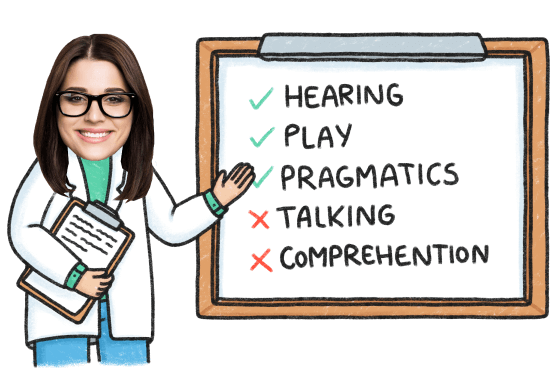Selective Mutism: An Introduction for Parents
Jan 20, 2022 Is selective mutism a speech or language disorder? Moreover, is it a real condition? I’m sure these are just some of the questions you have about this title. But don’t worry!
In this article, you will learn what it is, and also read about the ways to recognize it, treatments for selective mutism, and gain awareness about some of the myths pertaining to this disorder.
In This Article
What is selective mutism?
Selective mutism is an anxiety disorder in which a child is unable to speak in some settings (classroom or around strangers), but communicates at home with no difficulty. It usually starts in early childhood, between the ages of 2 and 4. Though rare, a child can develop selective mutism towards certain family members if they don’t see them as often. When it comes to the causes of this disorder, some researchers believe environmental and genetic factors may play a role.
Some signs you may notice in a child with selective mutism:
- The ability to easily speak at home, but not with others (kids at school or strangers);
- Avoidance of eye contact;
- Lack of facial expression when in feared situations;
- Social isolation/withdrawal;
- Timid temperament;
- Clinginess towards parents/caregivers;
- Separation anxiety;
- Uses nonverbal communication or whispers to communicate with others.
Common Myths
1. Selective mutism is a phase that children eventually grow out of.
This is false! It is not a phase, nor does it affect only children. It is an anxiety disorder that if left untreated, can persist during adolescence and adulthood.
2. Selective mutism is a form of autism.
While the symptoms may be similar to autism, they are different disorders. Children with selective mutism act differently depending on their environment. They may be nonverbal in school but are social and talkative at home.
3. Children have this disorder as a result of neglect or trauma.
One of the misconceptions we often hear is how children develop selective mutism as a result of trauma. In fact, studies tell us this sort of myth can be detrimental, as it may prevent a child from getting the proper treatment for their actual anxiety. (When mutism occurs due to post-traumatic stress, a child stops talking in environments where they previously had no difficulty speaking.)
4. Last but not least, selective mutism is a speech or language disorder.
It is not a speech or language disorder. However, it is possible for a kid with selective mutism to also have a speech or language impediment.
Is your child not talking? Take our free screener to get tips on how to help them:
Concerned that Your Child May Have Selective Mutism?
It is pivotal to talk to your child’s pediatrician and other health professionals (speech-language pathologists and psychologists) if you have concerns. Once diagnosed, there may be several forms of treatments used to aid your child. However, the efficacy of the treatments can depend on several factors such as the number of years a child has struggled with it or whether they have additional speech-related problems.
Common Treatments and Techniques Used by Health Professionals
Here is the latest on treating selective mutism:
Cognitive-behavioral therapy or CBT is a therapeutic tool used by health professionals to help a person focus on how they perceive themselves.
Exposure therapy (a form of CBT) is a method aimed at reducing fear by gradually exposing a child to situations they fear. Indeed, avoiding situations that cause a child to be anxious may seem to be the answer. Let’s be honest, we do it ourselves. However, doing so is not a solution, as it can further hinder a child’s behavior and reinforce their anxiety.
Stimulus fading is a technique in which you allow a child to interact with someone they talk easily with, but slowly allow a new person to join in.
In some cases, medication is often used for older children with severe forms of anxiety.
Positive reinforcement is another tool implemented in therapy to get a child to produce the desired behavior (e.g. toy or cookie or stickers).
Speech therapy: As previously mentioned, selective mutism is not a speech disorder. However, it is possible for a child to have a language and speech impediment in addition to selective mutism; in which case, they would need to receive speech therapy.
Boost Your Child’s Speech Development!
Improve language & communication skills with fun learning!

A Few Books on Selective Mutism
- Helping Your Child with Selective Mutism: Practical Steps to Overcome a Fear of Speaking by Angela E. McHolm, Charles E. Cunningham, and Melanie K. Vanier
- Maya’s Voice Book by Wen-Wen Cheng
- Overcoming Selective Mutism: The Parent’s Field Guide by Aimee Kotrba and Shari J. Saffer
If you suspect your child may be suffering from selective mutism, early intervention is very important. Contact a psychologist or a speech therapist to determine how to proceed. Taking steps as soon as possible can help your child overcome their challenges.

